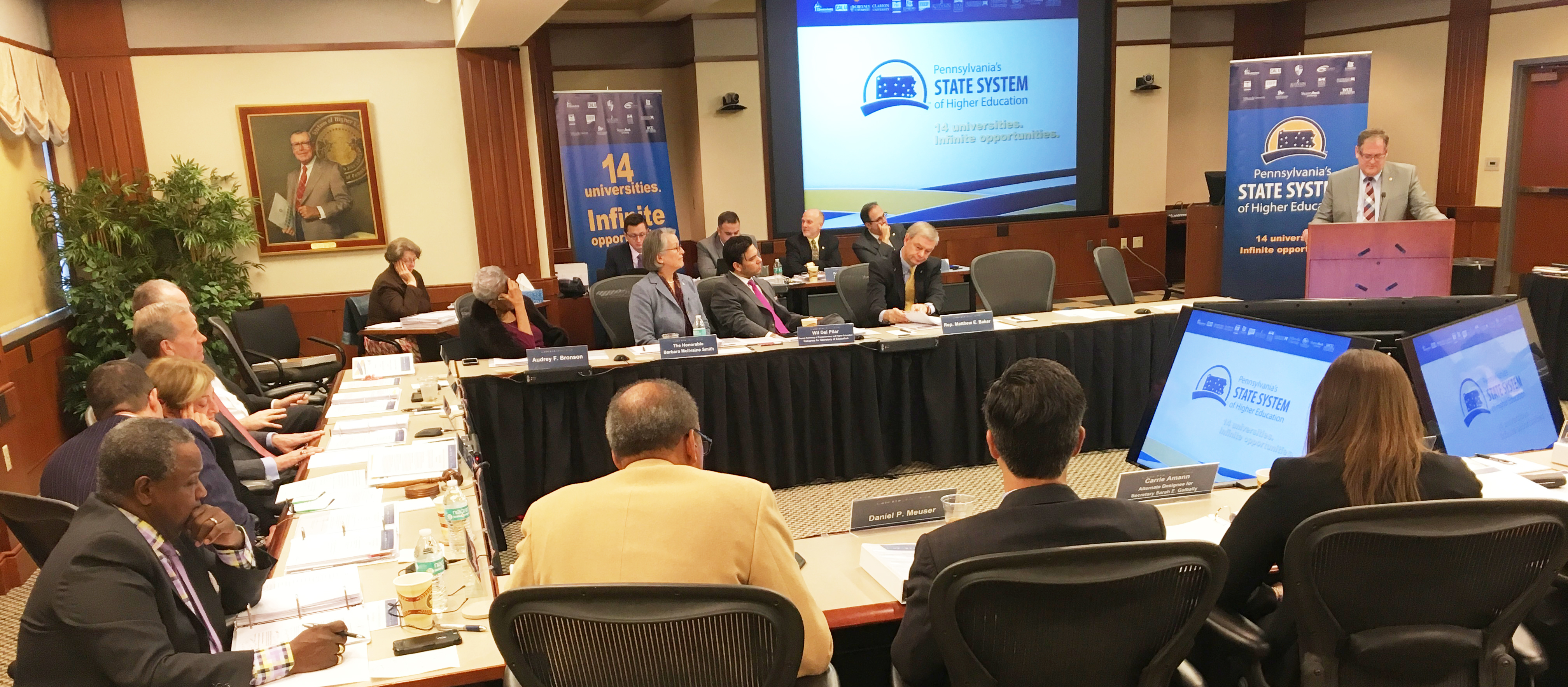Click here or on the image above to watch a video of Dr. Mash’s comments.
Chairwoman Shapira, governors, Chancellor Brogan, university presidents,
My name is Kenneth Mash, and I am president of the Association of Pennsylvania State College and University Faculties.
There are many methods of evaluating universities. In this system, we have certainly had our experience with performance indicators of every kind, and it seems that we constantly are flooded with comparative data from a variety of sources.
However, writing in The New York Times on Jan. 18, 2017, David Leonhardt points out an alternative means by which to judge America’s universities. He writes that despite ongoing budget, enrollment issues, and other issues, America’s public universities “remain deeply impressive institutions that continue to push many Americans into the middle class and beyond.”
This is not merely Leonhardt’s opinion; he bases it on a major study by the Equal Opportunity Project that was released last week. The study compares upward mobility rates, and as Leonhardt points out, America’s public universities fare far better that elite and private universities. In short, they are the engines of the American dream.
Online, the article is accompanied by a search engine that allows one to plug in universities to see how they fare in comparison with other universities in the country. I took the time to plug our universities into the charts, and what I found is that we certainly have room for improvement. Looking at who we are serving, the data says that 13 of our universities enroll between 9 and 25 percent of our students from the bottom 40 percent in terms of income.
Looking at mobility rates, that is graduates who move from the bottom 40 percent to the top 40 percent, 13 or 14 of our universities rank between 599th in the country and 1,807th. Our universities do fair better in comparison with other Pennsylvania universities; but relatively speaking to the universities across the country, our universities are rather low.
I would hypothesize that the explanation for this lies in the costs of attending college in our Commonwealth. I would further suggest that this is good reason, on top of all the other good reasons why we must advocate for further funding. I would also suggest that we collectively must pay attention to the costs to the students, not just in terms of tuition, but of total college costs. Are we shutting students out of attending our universities? We must do a better job overall of servicing Pennsylvania’s citizens and especially those who need it the most. How much do we even take this information into account? Are we even considering the impact on upward mobility when we discuss per-credit tuition or variable-tuition rates?
You will notice that in the data I just relayed I said 13 out of our 14 universities. I left one university out, and that was Cheyney University. For all of the negative things said about our HBCU and all of the problems it confronts, Cheyney enrolled nearly 54 percent of its students from the bottom 40 percent, and its mobility rate of 21.2 ranked it 87th in the nation, which is far superior to any of our other universities.
It is clear that when it comes to upward mobility, Cheyney is in a class by itself among our universities. Cheyney University has always played an important part in our system. And this data shows that it does for the Commonwealth’s students what no other of our universities do.
And here we are in a very bad situation with regard to that university. I have spoken much about Cheyney. I have been concerned that throughout this crisis that austerity and cutting budgets was not sufficient. That Cheyney could not survive without an alternative revenue stream. Bold thinking is what was required. How could we bring what Cheyney offers to underserved populations?
Cheyney’s immediate challenge is severe. Our Cheyney faculty have been clamoring for a permanent leadership team that would provide the necessary vision to lift the university out of the abyss. Our Cheyney faculty have been clamoring to be a part of the decision-making process. But their calls for participation have gone generally unheeded.
We need Cheyney University. Pennsylvania needs Cheyney University. I have made this point before: We all bear responsibility for that university’s circumstances, and we continue to bear it. For decades, things were allowed to happen there that would never have been tolerated by this board at any other university.
To get out of this mess, we will require joint effort in a very short time. The entire campus must be immediately engaged. This entire board must be engaged. Each of our universities ought to be helping. My association needs to know what it can do to help. To do otherwise is unacceptable. To give up is unacceptable. To throw up our arms, to scale Cheyney back, is likewise unacceptable. Anything other than working diligently to create a sustainable path is to give up — not just on Cheyney University, but on the dreams of upward mobility of the Pennsylvania students and families who rely on our university.
Thank you.

